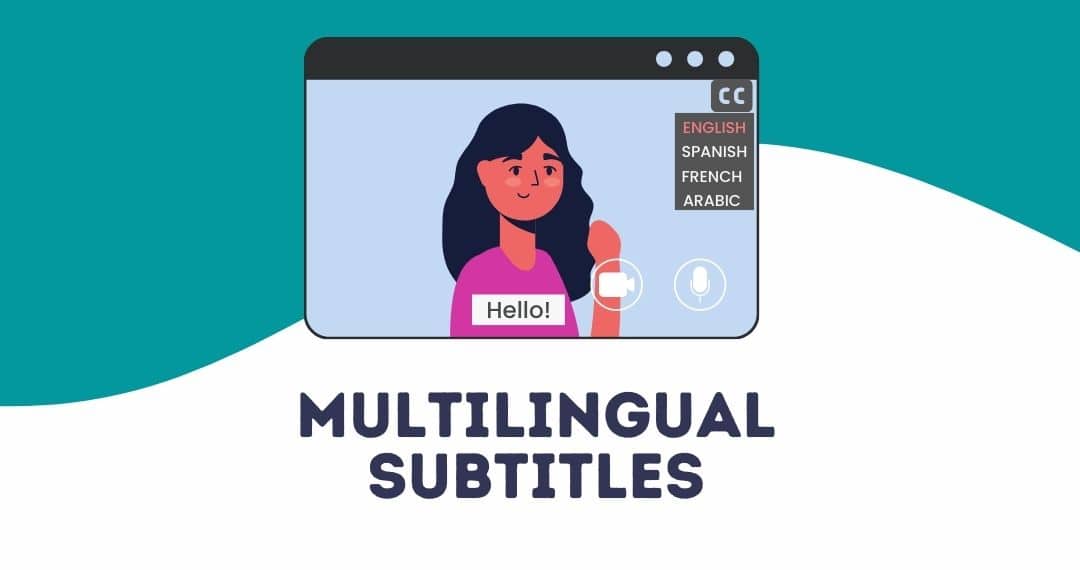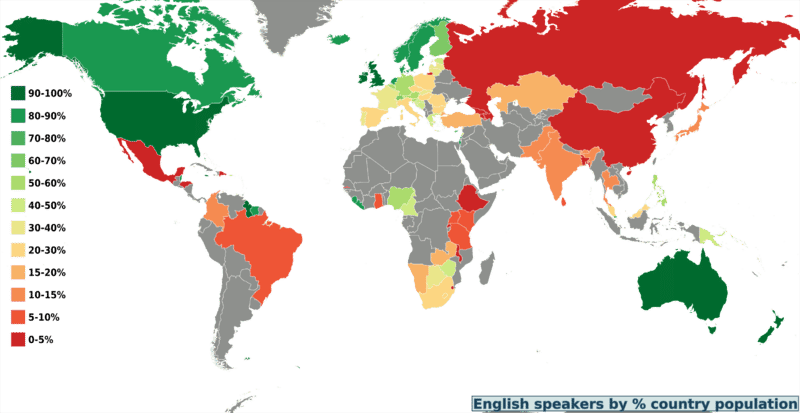By 2025, the global e-learning market will be worth as much as $325 billion. This sector has gained momentum during the pandemic, and now, most government and private organizations rely heavily on e-learning platforms to provide access to educational courses for their employees.
Due to the easy accessibility, e-learning platforms have become the most popular way of gaining new skills and expertise. However, due to the many players in the market, e-learning video producers might find it hard to get ahead of the competition.
Also read: eLearning Translation services: How to make learning international?
That’s why you have to make your content available in multiple languages. In this way, your multilingual content would attract new customers from all over the globe. All the non-English speaking users left out by your competitors will have access to your videos and will presumably be able to watch them in their native tongue.
But does it mean you have to refilm your whole content to make it available in new languages?
No! Multilingual subtitles are a great tool to effectively and cost-efficiently provide content in different languages.
You can take advantage of this trend so that your eLearning videos are accessible to a broader, multinational audience.
What’s more, subtitles can increase your online video viewing by as much as 40%. But the good news is that you can take advantage of so much more. In this blog, you can find everything you need to know about multilingual subtitles – from the creation process to benefits and tips on how to find the right partner.
DOWNLOAD OUR FREE EBOOK - 10 COST SAVING STRATEGIES FOR GLOBAL TRAINING LOCALIZATION
What are multilingual subtitles?
Subtitles are usually used as a text alternative for the spoken dialogue of narrators or characters in films. However, they can be utilized for several different video materials.
This includes e-learning videos.
When it comes to e-learning videos, you can create subtitles for the spoken explanations in multiple languages. In this way, the information of the video is made accessible to audiences who speak different languages.
Also read: Why Video Translation is Worth it
The process of creating subtitles
Creating subtitles is a long process that includes the following different steps:
Spotting & Transcription: The first step is to transcribe the audio of the video. This means that the whole spoken text is transferred into a written form.
(Sample spotting file created by Milestone Localization)
During the transcription process, linguists also note down the in and out times of every caption. This process is called spotting and ensures that the subtitles would appear and disappear at the very right moment.
SRT file creation: The SRT (SubRip) file is the most popular format for subtitles since it is easy to navigate and is compatible with various software and video platforms. This file contains your subtitles, including not only the transcribed text but also the time stamp and any other information.
Most professionals prefer this file format since you can adjust the transcribed text and the time stamps very easily by yourself. What’s more, you can easily convert it to any other file type.
Translation: Once the SRT file is created, the translators handle the translation work. They not only have to translate the text from the source to the target language(s) but also adapt and localize it to the target audience and their cultural system.
Translating subtitles is quite challenging since translators have to keep in mind the duration and length of each subtitle. They should not exceed certain criteria, such as the maximum number of characters per line or the maximum/minimum duration of a subtitle.
Testing: After all the above steps are finished, the video with its subtitles is reviewed or tested to ensure that everything operates properly. This part is crucial since with subtitles, the slightest mistakes can be overlooked.
This final testing stage ensures that the punctuation, timing, facts, figures, and names are correct and correspond to those in the source file.
The ideal end product is – subtitles perfectly attuned to the audio of the video. The language is simple, natural, and easy to comprehend, while the subtitles themselves stay long enough on the screen to be read without being in a rush. Indeed, the ultimate goal is that the viewer should be almost unaware that they are reading subtitles.
Benefits of multilingual subtitles for e-learning videos
Multilingual subtitles can be considerably beneficial in many aspects. Indeed, there are several different advantages that you should take into consideration if you are planning to launch or simply improve your online e-learning courses.
Reach wider international audiences
Providing multilingual subtitles means that you will be able to reach new audiences all over the world. What’s more, multilingual subtitles will help your videos resonate with a wider audience.
If you provide online courses only in English, you are unlikely to maximize the full potential of your content. Only 6% of the world population speaks English as a native language, while 75% don’t speak English at all.
In other words, your English content will reach only a tiny portion of the internet users.
Thus, creating subtitles in multiple languages will help you reach new learners from all around the globe. You don’t need to reshoot or change your videos. You only need to create captions in the local languages of your target audiences.
Remove barriers and boost your videos’ accessibility
Besides reaching international audiences around the globe, your courses will be accessible to basically anyone. Even people with hearing impairment would be able to enjoy your videos, presumably even in their native language.
What’s more, providing subtitles in different languages can help people who are watching your courses in a noisy environment or in a very quiet one where they cannot play the video with the sound on. Even people who have difficulties following fast-paced speech will benefit from subtitles.
Many companies create particular standards regarding their content, striving to make it accessible to anyone as much as possible. In this regard, multilingual subtitles can help you reinforce your brand image and message.
Easy, yet effective solution
Multilingual subtitles are an elegant and easy way to provide video content for your multilingual audience.
Shooting and editing a new video for each target group is time-consuming and costly. Instead, you can keep your video materials unchanged while being able to add an infinite number of subtitles in any language you want.
Improve your SEO
Investing in multilingual subtitles is investing in your marketing strategy as well. The more views your videos receive, the more organic traffic will be directed to your online courses.
Still, you have to keep in mind that your multilingual subtitles should be properly translated. Only good SEO translation will help you rank for keywords in different markets and languages.
Also read: Multilingual SEO – Importance, Benefits & The Process
Gain competitive advantage
Most of your competitors are probably already investing in subtitles, so if you want to keep your spot on the global market, you should do too.
What’s more, if you want to surpass your competitors, providing multilingual subtitles in various languages is the best way to do it.
In this way, you won’t leave any potential customers unsatisfied and, thus, have them go to your competitors. Instead, you can provide them with multilingual content and cater to their needs.
Cater to your customers’ needs
If you opt for closed captions or, in other words, subtitles that can be turned on and off, viewers can not only choose the language they want but also decide if they need subtitles at all.
You are still providing them with accurate subtitles in their language. However, they can choose themselves if they need them or not.
Having a list with all languages available would be extremely helpful to your customers as well. Imagine that a German user who is actively learning Chinese wants to practice their language skills while learning new things.
Being able to freely choose the language of the subtitles can be another way to show your customers that you care.
Boost your content engagement and customer satisfaction
Providing your customers with multilingual subtitles will inevitably boost your content engagement. Subtitles can be greatly beneficial to the learning process, especially for people with visual memory.
What’s more, research has shown that students learn better when different senses are involved in the process. In other words, if you provide your customers with the possibility to read and hear the information, they are more likely to retain more information.
Investing in multilingual subtitles can be beneficial to your learners, leading to greater customer satisfaction and boosting your content engagement. Learners would happily go back to your videos because they will be satisfied with the result.
Increase your online video views with multilingual subtitles
Milestone Localization can help your audio-visual content resonate with audiences across the world with our professional subtitling translation services in 70+ languages.
Which languages to choose for your multilingual subtitles?
There are so many languages out there, so you might be wondering which you should pick for your e-learning videos. Well, here are some suggestions:
Chinese: This is the fastest-growing language in the world and the second-fastest growing language on the Internet after English, with almost 20% of all internet users using it.
Spanish: There are around 800 million people around the world speaking Spanish and around half of them are native speakers. 8% of all internet users use Spanish, and the content in this language continues to grow.
Arabic: No one would have thought a few years ago that Arabic would have around 170 million internet users and will be among the top 10 fastest-growing languages on the internet.
Portuguese: Since 2011 Portuguese has experienced immense growth, and today 47% of all Portuguese speakers are connected to the internet. This means that over 130 million people on the internet use Portuguese.
Hindi: By the end of the year, the Hindi-speaking users on the internet are expected to reach 150 million.
Japanese: Similar to Portuguese, more and more content in Japanese is created on the internet, and this trend is not expected to slow down in the upcoming years. There are almost 115 million Japanese users on the internet, and the number is constantly growing.
Russian: There are over 129.8 million users online who use Russian.
Indonesian/Malaysian: There are nearly 100 million users on the internet who use Indonesian/ Malaysian, which makes it a good option for multilingual subtitles.
French: French is spoken in 29 countries across the globe, so it won’t be a surprise that almost 3 million people on the internet use this language.
German: 2.2% of all internet users use German, which makes it among the top 10 fastest-growing languages on the internet.
While choosing among the fastest-growing languages on the internet is a good strategy, you can also do your research to determine which languages will be most beneficial to your e-learning videos.
A good way to start is to have a look at the traffic to your online courses. Depending on the most common locations of your users, you can create a list of languages for your multilingual subtitles.
Also read: What are the Fastest Growing Languages?
How to choose the right partner?
Finding the right language service provider (LSP) will help you immensely along the whole process.
The right LSP will always be willing to discuss your projects and advise you on what possibilities are out there for you. So, always look for a partner who will not only provide you with a quality translation but also guide you along the way.
When looking for a suitable LSP, there are a few aspects you have to keep in mind:
How many languages does the LSP offer? The more, the better, right. But most importantly, look for an LSP who can provide translation services for all your multilingual projects. In other words, look for partners that offer multiple languages for translation.
What is their expertise? E-learning videos are a separate domain and as such, you need to have the skills and expertise to work on such videos. Thus, you need to ensure that the LSP you choose to work with does work with specialists who can handle e-learning videos.
Do they actually offer subtitling services? Make sure that your LSP offers this service. Simply having your video transcribed and translated won’t be enough. You need to work with professionals who know how to handle subtitles professionally and have the appropriate software for this job.
What video formats do they support? There are all kinds of video formats out there. So, you have to make sure that the LSP you work with utilizes software that supports the file formats of your videos.
Choosing the right LSP is essential since multilingual subtitles are an ongoing project. This means that you will constantly add new languages to your videos. Working with the same LSP, on the other hand, will ensure consistency, more efficient workflow, and even cost savings in the long run.
Also read: 7 Reasons To Work With a Translation Company on Your Next Project
In conclusion
While subtitles are commonly used for movies, they are becoming an increasingly beneficial tool in many other domains, especially for e-learning videos. Indeed, multilingual subtitles are the best way to reach out to new, international audiences while leveraging the full potential of the internet to provide them with new skills and knowledge.
Multilingual subtitles can not only improve the learning process, but they also bring about many other benefits regarding accessibility, cost-efficiency, improved organic search ranking and increased views and viewing duration.
Increase your online video views with multilingual subtitles
Milestone Localization can help your audio-visual content resonate with audiences across the world with our professional subtitling translation services.















